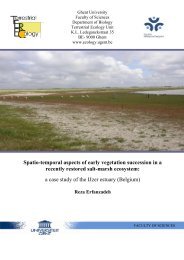PhD Arthur Decae 2010 - Ghent Ecology - Universiteit Gent
PhD Arthur Decae 2010 - Ghent Ecology - Universiteit Gent
PhD Arthur Decae 2010 - Ghent Ecology - Universiteit Gent
Create successful ePaper yourself
Turn your PDF publications into a flip-book with our unique Google optimized e-Paper software.
Spermathecae (Fig. 67) tripartite, "hourglass-shape", evenly covered with very thin glandular<br />
tissue.<br />
Variation (n=6): Females medium sized spiders, B L= 19-21, CL= 6.5-8.0. Carapace,<br />
CL/CW = 1.1-1.2, CL/Ca = 1.6, Ch/Th = 1.9-2.5. Clyp = 0.3l-0.36. Eye- formation: AR/PR =<br />
0.96-l.00, AR/El = 1.87-2.14, ALE/ PLE = 1.18-1.38. POP entirely or indistinctly broken<br />
between AME. PSPvar: p = 1(2-3); I = 1(2); II = 1(2); III = 2(0-1); IV = 0. Leg IV:<br />
F4>T4≥M4. Spinnerets: PMS with two or three fine spigots on apex. Fang-keel: serrated<br />
(rarely smooth). Abdominal pattern more or less distinct. Male: unknown.<br />
Burrow (Fig. 74): Nemesia ibiza builds a typica1 cork- burrow, with a thick trapdoor that fits<br />
within the entrance of the burrow-tube. The depth of the burrow is usually around 12 cm, but<br />
may vary between 7-16 cm. The maximum diameter of the trapdoor measured in the field was<br />
1.8 cm, and the diameter of the burrow entrance was 1.75 cm. There are no internal sidediggings,<br />
but the burrow may bend in various ways, probably around underground obstacles.<br />
Most of the burrows are dug in steep or vertical clay-fillings between natural rock-layers or in<br />
constructed stone walls. The silk lining of the burrow is thickest near the burrow-entrance and<br />
vanishes completely a few centimeters down the shaft. Indigestible chitin-chips and remains<br />
of prey are stored in a compacted package pushed into the lower burrow-wall, or in the<br />
burrow-bottom. Identified prey- remains were similar to those found for N. santeulalia.<br />
Figs. 68-74: Longitudinal sections of Nemesia burrows showing different tube shapes and types of trapdoors,<br />
extent of silk burrow lining (dashed lines), presence or absence of prey remains in pockets associated with the<br />
burrows (pr), presence of a second trapdoor (d), and positions in which the spiders were usually encountered<br />
during collection. 68 N. brauni (aggressive, ready to attack at burrow bottom); 69 N. bristowei (defensive<br />
posture, inactive at burrow bottom); 70 N. randa (defensive posture, inactive at burrow bottom); 71 N.<br />
santeugenia (halfway up burrow ready to escape); 72 N. seldeni (halfway up burrow ready to escape); 73 N.<br />
santeulalia (hiding in side branch); 74 N. ibiza (aggressive, ready to attack at burrow bottom). Arrows indicate<br />
opening direction of trapdoors. Scale line = 1cm.










